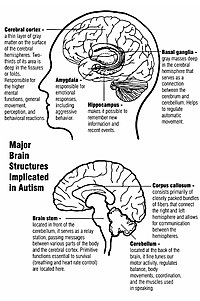
Photo from wikipedia
The ability of early factors to predict low language abilities at 7 years is explored together with the degree and nature of co-occurring difficulties present. OBJECTIVE: To examine at 7… Click to show full abstract
The ability of early factors to predict low language abilities at 7 years is explored together with the degree and nature of co-occurring difficulties present. OBJECTIVE: To examine at 7 years the language abilities of children, the salience of early life factors and language scores as predictors of language outcome, and co-occurring difficulties METHODS: A longitudinal cohort study of 1910 infants recruited at age 8 to 10 months. Exposures included early life factors (sex, prematurity, birth weight/order, twin birth, socioeconomic status, non–English speaking background,family history of speech/language difficulties); maternal factors (mental health, vocabulary, education, and age); and child language ability at 2 and 4 years. Outcomes were 7-year standardized receptive or expressive language scores (low language: ≥1.25 SD below the mean), and co-occurring difficulties (autism, literacy, social, emotional, and behavioral adjustment, and health-related quality of life). RESULTS: Almost 19% of children (22/1204;18.9%) met criteria for low language at 7 years. Early life factors explained 9-13% of variation in language scores, increasing to 39-58% when child language scores at ages 2 and 4 were included. Early life factors moderately discriminated between children with and without low language (area under the curve: 0.68–0.72), strengthening to good discrimination with language scores at ages 2 and 4 (area under the curve: 0.85–0.94). Low language at age 7 was associated with concurrent difficulties in literacy, social-emotional and behavioral difficulties, and limitations in school and psychosocial functioning. CONCLUSIONS: Child language ability at 4 years more accurately predicted low language at 7 than a range of early child, family, and environmental factors. Low language at 7 years was associated with a higher prevalence of co-occurring difficulties.
Journal Title: Pediatrics
Year Published: 2017
Link to full text (if available)
Share on Social Media: Sign Up to like & get
recommendations!